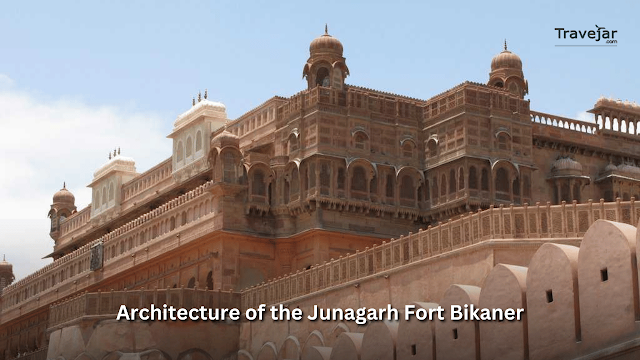Exploring Junagarh Fort: A Golden Gem in Rajasthan's Desert Landscape
The majestic Bikaner Junagarh Fort is the center of the city Bikaner, which was built around it. Originally known as Chintamani, the fort was renamed the Junagarh or Old Fort throughout the 20th century. Rao Bika laid the Junagarh fort's foundations in 1478. The current opulent building was officially opened on February 17th, 1589.
The palaces inside the fort, the gardens, balconies, kiosks, etc., show a fusion of architectural styles influenced by the varied cultural backgrounds and outside influences of the kings. The unusual monuments on display at the fort depict 16 successive generations of Bikaner kings beginning in the late 16th century.
A royal temple called "Ratan Bihari temple" is also situated in Junagarh Fort is a fort in the city of Bikaner, Rajasthan, India. One of the best Places to visit in India ; this shrine is a must-visit during the Gangaur festival and Dussehra. There is also a museum, which Maharaja Dr. Karni Singhji founded in 1961. Numerous manuscripts written in Persian and Sanskrit, jewels, farmans (royal orders), portrait galleries, costumes, enamelware, silver, palanquins, howdahs, and war drums are displayed. Red sandstone and marble are used in the construction of Junagarh Fort. The fort showcases the Maharajas' opulent way of life.
History
However, all but one fell short. Babur's son Kamran Mirza took control of the impressive fort for only one day in 1534, under Rao Jait Singh's authority. Under the leadership of Raja Rai Singh, the city of Bikaner prospered from 1571 until 1611. Raja Rai Singh embraced Mughal sovereignty and held important positions under Akbar and Jehangir's administration. His triumphs in numerous battles earned him numerous honors and jagirs.
Raja Rai Singh began construction on the Junagarh fort after securing a position under the Mughal administration. The groundbreaking ceremony for this magnificent fortification took place on February 17, 1589, and construction was finished on January 17, 1594. Raja Rai Singh, an artist and knowledgeable architect, planned the fort as a regal building in the middle of the Thar Desert.
Also Visit : First Timers Jaipur Trip for International Travelers
Architecture of the Junagarh Fort Bikaner
The layout of the Junagarh fort is rectangular, with a length of around 1078 yards. It encompasses 63119 square yards of space. The previous stone fort built by Rao Bika was initially protected by the new fort. It once had a moat for security reasons, but there is none today. Many palaces with excellent designs are enclosed by the impressive castle. The tradition and culture of the ruler who created them may be seen in all of the balconies, gates, kiosks, and other buildings.
The stone sculptures created in red and gold sandstone are one of Junagarh Fort's most notable characteristics. Red sandstone is used to build every edifice. The interior design is based on traditional Rajasthani architecture. The opulent fort contains seven gates, numerous mansions, and Jain and Hindu temples Explore this place with Rajasthan Tour Packages .
Two large gates are likewise constructed of golden sandstone. The Suraj pol is currently used for entry in place of the earlier Karan Pol. Due to its eastward orientation, the Karan pol receives the first sunbeams. The golden rays on the yellow sandstone are both a lovely sight and a good omen.
The opulent architecture of this fort and the beautiful beauty of each structure bear evidence of the regal way of life that was once led here many years ago.
Also Visit : Explore India's Hidden Gems: Top 5 Unexplored Places To Visit In 2024
Structure of Junagarh Fort
There are many exquisitely constructed buildings, kiosks, and palaces within the Junagarh Fort. The glories of architecture are sufficient to enthrall visitors.
Gates of Junagarh Fort
Daulat pol (double gate), Chand pol, and Fateh Pol are the fort's other entrances. All of the women who performed Sati on the funeral pyres of their husbands who lost their lives in war have left numerous handprints on the Daulat Pol. Each gate is deserving of the magnificent palace it leads to.
Also Visit : 5 Famous Stepwells In India You Absolutely Must Visit
Temples in Junagarh Fort
Museum of Junagarh Fort
Maharaja Dr. Karni Singhji constructed the fort's museum in 1961. The museum contains a variety of artwork, jewelry, and other remembrances that portray the former royal life that the fort once witnessed.
Timings Junagarh Fort
The public is welcome to Junagarh Fort from 10:00 a.m. until 4:30 p.m. Every day of the week, including official holidays, the fort is open. The entire fort may be explored in two to three hours because there are so many structures to explore.
Entry Fees Junagarh Fort
To enter Junagarh Fort, visitors must pay a charge. Adult tickets for Indian visitors cost Rs. 50, while student tickets cost Rs. 30. Adult tickets for foreign visitors cost Rs. 300, and student tickets cost Rs. 150. Tourists are not charged to use still cameras, but they must pay Rs. 100 to carry video cameras.
There is a museum that opens at 9:00, and visitors must purchase a separate Rs. 20 fee for entry. Tourists must pay Rs. 20 to bring a still camera into the museum and Rs. 100 to bring a video camera. Tourists must pay Rs. 100 to visit Chandra Mahal and Phool Mahal. Tourists must pay Rs. 350 for adults and Rs. 200 for students for the audio tour.
Best Time to visit Junagarh Fort
October to March is the ideal season to explore Bikaner and Junagarh Fort. Despite the extreme cold in December and January, people can still enjoy visiting the location. The hot and muggy weather from April to September prevents tourists from enjoying their trip.
How to reach Junagarh Fort
Via Air
The airport in By Air Bikaner just opened in 2014. The city is 13 kilometers from the airport. No flights are currently arriving at the airport or leaving it, but the government is working to get some flights going shortly. Jodhpur has the closest airport to Bikaner. Air travelers can fly to Jodhpur, and then take a train or a taxi to Bikaner.
Via Train
As many long-distance and short-distance trains originate in Bikaner or travel to other places via Bikaner, Bikaner is connected to numerous cities by train. Although the city does not have any Rajdhani, Shatabdi, or Garib Rath trains, it is connected to other cities by express and fast mail trains as well as superfast trains. Delhi, Mumbai, Chennai, Kolkata, Jaipur, Jodhpur, Jaisalmer, and more cities are connected to Bikaner.
Via Road
By Road, Bikaner has excellent road transportation connections to numerous places. To travel from Bikaner to adjacent cities, tourists can either hire a taxi or board a state-owned or private bus. Visitors can take direct buses to several other places, including Delhi, Jaipur, Agra, Ahmedabad, Pune, Jodhpur, Mumbai, and Jaisalmer.
Local Transport
Bikaner is a very well-liked tourist destination, and visitors can either hire a taxi or take an auto-rickshaw to view the city's various locations. Some roads are frequently obstructed by sand dunes as a result, visitors can rent bicycles at the railway station to go about the city.
Conclusion
The Junagarh Fort in Bikaner, Rajasthan, stands as a testament to architectural brilliance and rich history. Initially laid by Rao Bika in 1478, its current opulent form was realized by Raja Rai Singh in the late 16th century. Fusion of styles and exquisite craftsmanship make it a must-visit destination, showcasing regal opulence and cultural depth.









Comments
Post a Comment